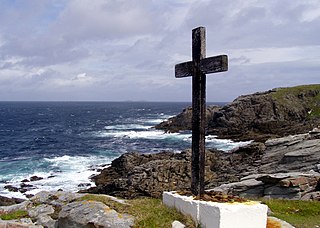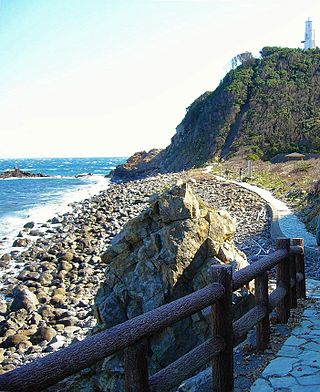
Yonaguni is a town located entirely on Yonaguni Island in Yaeyama District, Okinawa Prefecture, Japan. It is the westernmost municipality in Japan, and is known for billfish fishing and as a diving spot. In 1987, divers discovered the Yonaguni Monument, a rock formation that some believe may be man-made.

This is a list of the extreme points of Ireland – the points that are farthest north, south, east or west in Ireland. It includes the Republic of Ireland and Northern Ireland.
This is a list of the extreme points of Europe: the geographical points that are higher or farther north, south, east or west than any other location in Europe. Some of these positions are open to debate, as the definition of Europe is diverse.
This is a list of the extreme points of Asia, the points that are farther north, south, east or west than any other location on the continent.
The extreme points of Norway include the coordinates that are farther north, south, east or west than any other location in Norway; and the highest and the lowest altitudes in the country. The northernmost point is Rossøya on Svalbard, the southernmost is Pysen in Mandal, the easternmost is Kræmerpynten on Svalbard, and the westernmost is Hoybergodden on Jan Mayen. The highest peak is Galdhøpiggen, standing at 2,469 m (8,100 ft) above mean sea level, while the lowest elevation is sea level at the coast.

The Ōsumi Peninsula projects south from the Japanese island of Kyūshū and includes the southernmost point on the island, Cape Sata. Its east coast lies on the Pacific Ocean, while to the west it faces the Satsuma Peninsula across Kagoshima Bay. Politically it is part of Kagoshima Prefecture. Lava erupted in 1914 by Sakurajima made a land connection with the northwest of the Ōsumi Peninsula.

Cape Irizaki is the western tip of Yonaguni Island and the westernmost point in Japan. The cape is within the town of Yonaguni, Okinawa.
Torishima, Tori-shima or Tori Shima, is a Japanese toponym or personal surname. Most versions of the name have the meaning Bird Island, with some exceptions.

Cape Hedo, also known as Hedo Point, is the northernmost point on Okinawa Island, located within Kunigami Village. A cape jutting out north from the island, it faces the South China Sea on the west, and the Pacific Ocean on the east. On a particularly clear day, the island of Yoron (Yoronjima) in Kagoshima Prefecture can be seen on the horizon. Yoron Island is located approximately 23 kilometres (14 mi) to the north.

Japan is currently engaged in several territorial disputes with nearby countries, including Russia, South Korea, North Korea, the People's Republic of China, and the Republic of China (Taiwan).

Cape Kamoda is a headland at the easternmost point of the Japanese island of Shikoku, in the city of Anan, Tokushima Prefecture. The promontory extends into the Kii Channel and is situated within Muroto-Anan Kaigan Quasi-National Park. Above the cape is Cape Kamoda Lighthouse, which started operating in 1924; from its observatory it is possible to see Cape Hi in Wakayama Prefecture, Ōnaruto Bridge, and Awaji Island. In 2010 a stone sculpture known as "Wave Song" (「波の詩」) was erected nearby. North of the cape lies Maiko Island, while I Island is to the east. The sandy beach to the north is an egg-laying ground for loggerhead sea turtles and has been designated a Prefectural Natural Monument. In late autumn and winter, so-called "Daruma Sunrises" sometime occur, with the sun appearing in the shape of the Greek letter omega Ω.













